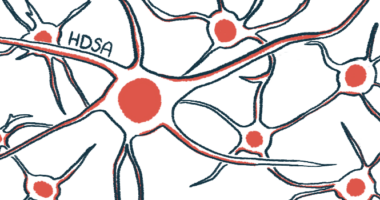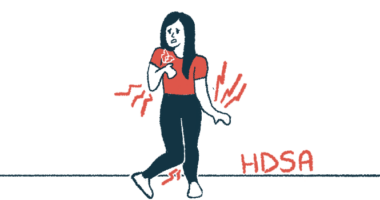Occupational therapy for Huntington’s disease
Last updated June 11, 2025, by Susie Strachan

Occupational therapy can improve the quality of life in people with Huntington’s disease — a progressive genetic disorder that affects movement, thinking, and emotions — by helping to make everyday activities, like walking and dressing, easier.
An occupational therapist can work with you to modify your home for safety and create consistent routines. They can also suggest certain types of adaptive equipment made for Huntington’s disease to help you and your caregivers manage the disorder’s progression more effectively.
Goals of occupational therapy in Huntington’s disease
Occupational therapy for Huntington’s disease helps people reduce the impact Huntington’s symptoms have on daily activities and across the stages of the disease.
- In the early stages, an occupational therapist may suggest tools like adaptive utensils and energy-saving techniques to make daily tasks easier and improve quality of life.
- During the middle stages, when movement and balance become less reliable for people living with Huntington’s, a therapist may recommend home adjustments and modifications to improve safety and accessibility, helping reduce risks from mobility and coordination issues.
- In the late stages, the focus shifts to maximizing comfort and safety, with strategies like preventing falls, specialized seating, and changing position to reduce pressure points.
Therapists also work with caregivers and family members by offering guidance on proper positioning, adaptive equipment, and stress management.
Benefits of occupational therapy in Huntington’s disease
Managing daily activities in Huntington’s disease requires a balance of practical strategies and personal support.
Occupational therapy can help you manage chorea — a hallmark of Huntington’s that involves sudden, involuntary movements — and mobility challenges with practical techniques. It can also provide support for mental health as cognitive ability decline and offer techniques for fatigue management.
Motor skills and mobility
Occupational therapy can help you maintain mobility, especially when unpredictable movements like chorea make actions like walking difficult.
It can also help your caregivers adapt your home environment to support your changing needs, including reducing the risk of falls.
Cognitive support
Occupational therapists understand the emotional challenges of living with Huntington’s and can adjust their support as the disease progresses.
Occupational therapy can help with thinking, memory, and organization to make daily tasks easier.
It can also be done in tandem with other services like social work or psychiatry to support cognitive rehabilitation in Huntington’s disease.
Activities of daily living
Occupational therapy helps with daily tasks like grooming, eating, and dressing by making these tasks easier and reducing the physical strain caused by motor impairments.
The goal is to help you establish self-care routines and maintain as much independence as possible.
Mental health and emotional well-being
Occupational therapy can help support your mental health by encouraging participation in hobbies and social activities. These activities can provide a sense of purpose and help combat feelings of isolation or loss.
Additionally, therapists can help individuals and caregivers learn how to manage mood swings, irritability, and emotional outbursts, which can be more common in the earlier stages of Huntington’s.
Tools and strategies used by occupational therapists
Occupational therapists employ various tools and techniques to help people with Huntington’s disease manage daily life.
Motor skills and mobility
In the early stages, therapists may recommend adaptive tools and energy-saving strategies. They may also focus on improving balance and posture to reduce fall risks, suggesting aids like walkers, grab bars, and non-slip mats for stability.
For more severe chorea, they may recommend wheelchairs and supportive transport to provide support, helping with posture, comfort, and mobility while minimizing the impact of involuntary movement.
As the disease progresses, therapists may guide caregivers on regular position changes to prevent skin damage and suggest padding furniture and sharp edges to reduce injury risks. They may also recommend splints to help align limbs, slow muscle contracture, and improve comfort.
Cognitive support
As memory and organization become more challenging, a therapist can introduce practical tools to support thinking and memory.
Planners, apps, and visual cues can help with time management and recall. For example, color-coded reminders or digital calendars might help you keep track of appointments, and labeling cupboards can help you remember their contents.
These tools and strategies can help establish structured routines to make daily life more predictable and reduce the mental effort required to make decisions.
Techniques for daily life
A therapist can help you use adaptive tools, such as specialized utensils, dressing aids, or shower chairs to simplify the tasks associated with daily living.
For example, if you have motor impairments that make meal time difficult, they may recommend:
- using specialized adaptive equipment, such as modified utensils for better grip, plate guards, suction cup bowls, cups with straws or lids, and/or a non-slip placemat to help you eat more easily, which may help prevent weight loss
- using a kitchen timer to remind you to turn off appliances
- sitting close to the table and resting your elbows on the table for upper body support to reduce fatigue.
In addition to eating difficulties, starting, stopping, and completing a series of tasks can become especially challenging over time.
For activities that involve multiple steps, like making a cup of tea, occupational therapists can teach you how to break the task into small, simple steps, including adding periods of rest, to prevent fatigue.
Finally, Huntington’s can make choosing and putting on clothes difficult due to decision-making challenges, weakened hand muscles, and chorea. Therapists may recommend:
- putting together easy-to-wear combinations, such as pairing a favorite shirt with matching pants, and labeling them with the day of the week to eliminate having to decide what to wear
- opting for clothing without multiple fasteners, making putting it on and taking it off easier.
Role of caregivers in occupational therapy
As a caregiver, you can support your loved one with Huntington’s by helping with daily activities like dressing, eating, and personal care.
Due to motor control challenges, these tasks can become increasingly difficult, but your presence and assistance can improve their ability to manage them. You might also help with mobility, posture, and positioning, offering physical support when needed.
When your loved one experiences irritability or emotional outbursts, you can help by creating a calm, structured environment. De-escalation techniques and gentle reassurance can help them feel safe and understood.
Taking care of yourself is just as important. As a caregiver, finding time for respite, seeking counseling if needed, and connecting with support groups where you can share experiences and find encouragement are vital.
This support helps you manage your well-being and allows you to continue providing compassionate care.
When to start occupational therapy
Early treatment after receiving a Huntington’s diagnosis can help slow functional decline and improve long-term outcomes. Signs to watch for include difficulty with daily tasks, increased falls, or challenges with memory and focus.
Occupational therapy can be combined with other supportive therapies, such as physical therapy for mobility and strength, speech therapy for communication and swallowing difficulties, and other complementary therapies like music or recreational therapy to enhance emotional expression and improve social engagement.
Finding an occupational therapist
To locate specialists experienced in Huntington’s, families can:
- contact organizations like the Huntington’s Disease Society of America and the Huntington Society of Canada
- seek recommendations through Huntington’s support groups and personal healthcare providers.
Huntington’s Disease News is strictly a news and information website about the disease. It does not provide medical advice, diagnosis, or treatment. This content is not intended to be a substitute for professional medical advice, diagnosis, or treatment. Always seek the advice of your physician or other qualified health provider with any questions you may have regarding a medical condition. Never disregard professional medical advice or delay in seeking it because of something you have read on this website.
Recent Posts
- What I want medical students to know about Huntington’s and bias
- Ingrezza treatment eases disease burden due to Huntington’s chorea
- A murder trial opened my eyes about Huntington’s and face reading
- What I want people to stop saying about Huntington’s disease
- HDSA 2025: Dance classes may improve balance in Huntington’s
- HDSA 2025: Long-term care transition requires communication
- Guest Voice: Huntington’s disease is rare, but love isn’t
- HDSA 2025: Observational studies in Huntington’s now enrolling in US
- HDSA 2025: Speakers spotlight Huntington’s clinical trials
- HDSA 2025: Speech therapy can help Huntington’s disease patients





